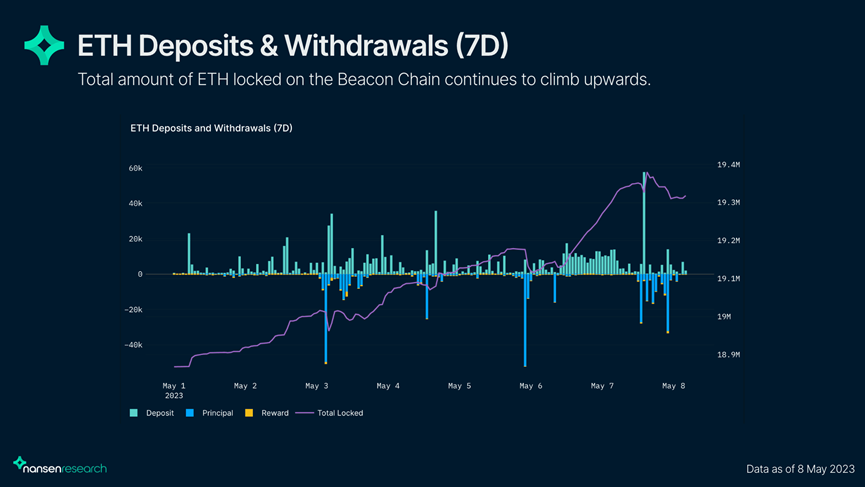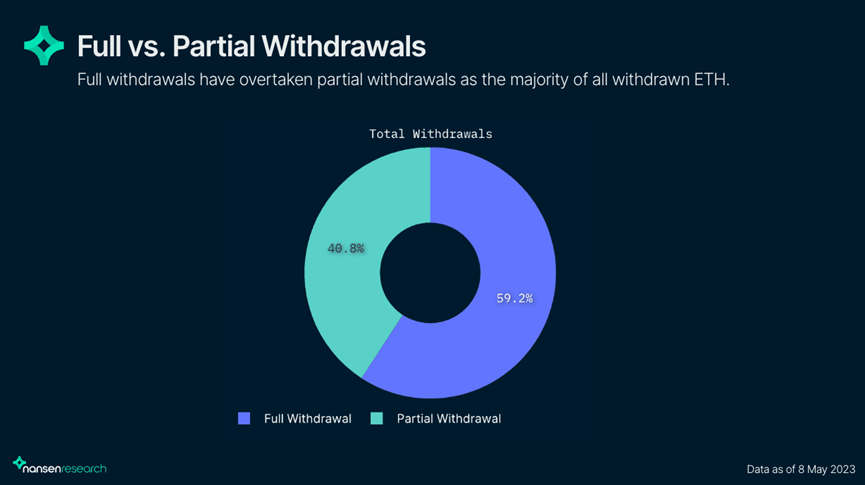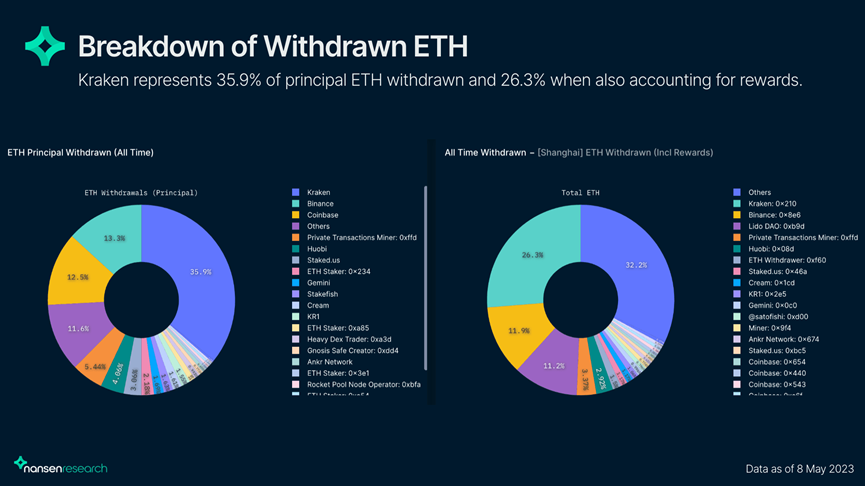Nansen: On-chain data analysis after the Ethereum Shanghai upgrade
Original: 《State Of Ethereum: A Post-Shapella Update》
Author: Tharm Lertviwatkul, nansen
Compiled by: Kate, Marsbit
Key Points
• There are currently 19.3 million ETH on the beacon chain (including rewards), equivalent to the amount of ETH on the beacon chain during the Shapella upgrade, which means its impact on the network so far has been zero.
• Full withdrawals have exceeded partial withdrawals, now accounting for 59.2% of all withdrawn ETH, while partial withdrawals account for 40.8%.
• Kraken has the highest withdrawals, totaling 647k ETH, which accounts for approximately 26.3% of all ETH withdrawals since the upgrade, followed by Coinbase, Binance, and Lido.
• Approximately 150k ETH (0.78%) on the beacon chain is planned to be withdrawn, while 99.22% of ETH remains staked. Coinbase currently holds the most ETH in the withdrawal queue (40% of the total).
• The estimated ETH entering circulation from the beacon chain is currently 25k-35k ETH per day.
Introduction
Last month's Shapella implementation was the most anticipated event for Ethereum and its community since the merge, primarily because it enabled withdrawals of staked ETH from the beacon chain. This event sparked debates on whether the ecosystem is bullish or bearish. Bears argue that the influx of unstaked ETH into circulation will lead to sustained selling pressure, while bulls believe that the risk of being unable to withdraw has been eliminated, leading to more deposits.
As a follow-up to the Shanghai Selling Pressure Report, we presented the state of the network prior to the hard fork, and this report aims to provide insights into the current state of the Ethereum network post-Shapella. Specifically, we delve into:
On-chain data and statistics to better understand the flow of withdrawn ETH to deposits,
- Which entities have exited?
- Where is the withdrawn ETH going?
- Breakdown of current withdrawal activities and the withdrawal queue
- Estimated time required for withdrawals under current conditions,
- And predict the daily amount of ETH leaving the beacon chain.
Overall, this report provides a deeper understanding of the current state of the Ethereum network and helps gauge potential selling pressure as well as the dynamics of ETH flow from investors and entities.
Details of Unstaking

Our definitions stem from the deposit and withdrawal processes, as illustrated in the image above:
• Total locked ETH: Currently on the beacon chain (including rewards and ETH waiting to be withdrawn) + ETH deposited into the mainnet beacon chain deposit contract but not yet credited to the beacon chain.
• ETH waiting/planned for withdrawal: ETH currently scheduled for withdrawal. This includes
- Rewards (0x01): All validator balances that have upgraded to 0x01 withdrawal credentials with a balance > 32 ETH.
- Voluntary exits: All validators with a balance ≤ 32 ETH that have initiated an exit but have not yet passed through the exit queue and have reached the exit period.
- Exits not slashed: All un-slashed validator balances that have passed through the exit queue but are still within the 27-hour exit delay and have not yet exited.
- Exits slashed: All validator balances of validators that have passed through the exit queue but are still within their approximately 36-day exit delay and have not yet exited.
- Withdrawable: All validator balances of validators that have passed their withdrawal delay (now withdrawable) and can be included in the scan.
- Withdrawn: All validator balances of validators that have passed the withdrawal delay (now withdrawable) and can be included in the cleanup.
• Partial/reward withdrawals: All balances > 32 ETH of full exiters that have "arrived" on the mainnet.
• Full/principal withdrawals: All balances ≤ 32 ETH of full exiters that have "arrived" on the mainnet.
• Exit queue: Time from initiating the exit to entering the queue (~25 minutes) + actual exit queue (variable) + exit delay (27 hours).
Advanced Post-Shapella Data Points

During the upgrade, there were approximately 19.3 million ETH on the beacon chain (about 19.1% of the circulating supply). Since then, a total of 2.43 million ETH has been withdrawn, 2.2 million ETH has been deposited, and 102k ETH has been burned, resulting in approximately 130k ETH entering circulation. Including unallocated rewards, there are still 19.3 million ETH staked on the beacon chain, meaning that so far, the net impact of Shapella on ETH is zero.
There are 600k active validators protecting the network. However, currently, about 4.5k validators are in the exit queue (voluntary exits), meaning they are waiting for full withdrawals. Since the number of active validators matches the number of exiting validators, and the total amount of ETH on the beacon chain has remained relatively stable since Shapella, the upgrade has had no impact on the Ethereum network.
Details of Withdrawn ETH

In the first two weeks following the Shapella event, partial withdrawals accounted for the majority of all withdrawn ETH. This is because each validator scan (~daily) automatically processes partial withdrawals, and the only requirement for validators is to provide a withdrawal address. On the other hand, validators wishing to fully withdraw must choose to exit the network and wait in the exit queue, which can take weeks (this is the reality). Full withdrawals have now exceeded partial withdrawals, accounting for 59.2% of all withdrawn ETH, while partial withdrawals account for 40.8%.
Entities with the Most Withdrawals

So far, Kraken has been the entity with the most withdrawals, totaling over 647k ETH, with principal tokens making up the majority. Since the upgrade, Kraken's withdrawal volume accounts for approximately 26.3% of all ETH withdrawals. This is due to recent regulatory crackdowns on staking services at exchanges, forcing them to return staked ETH to depositors on their platforms. Kraken staked about 1.4 million ETH through their services, meaning about half of the ETH is still on the beacon chain.
After a recent round of withdrawals, Coinbase is now the second-largest entity by withdrawal volume, with approximately 344k ETH withdrawn.
Although Lido currently ranks fourth in withdrawal volume, all withdrawals come from staking rewards, which are automatically processed with each validator scan. However, it is worth noting that Lido V2 will support staking withdrawals and permissionless node setups, planned for release on the mainnet in mid-May.

Kraken contributed 26.3% of the ETH withdrawn from the beacon chain. However, if only the principal amount withdrawn is considered, this percentage is much higher, with exchanges accounting for 35.9% of the 1.44 million ETH principal withdrawn so far. Other notable major ETH withdrawers include Binance, Coinbase, and private trading miners: 0xffd, accounting for 13.3%, 12.5%, and 5.44% of the major ETH withdrawn shares, respectively.
Withdrawal Activities
Withdrawal Queue
The vast majority of staked ETH on the beacon chain (99.22%) has no planned withdrawals, with only 150k ETH (0.78%) waiting to be withdrawn from 4,500 different validators. The composition of ETH withdrawers by category is as follows:

Most of the ETH in the withdrawal queue comes from validators fully exiting their stakes (voluntary exits, potential exits, and un-slashed exits), some of which may indicate upcoming selling pressure. On the other hand, ETH withdrawn from exchanges like Kraken (which accounts for a large portion of full withdrawals) may not be sold, as depositors may wish to re-enter through DeFi or other staking solutions.
Current Withdrawal Wait Times

Partial Exits
Since staking rewards are automatically processed with each validator scan, eligible validators (those with 0x01 credentials) do not need to take any further action.
A validator scan refers to when validators plan to propose the next block. Validators are also responsible for building a withdrawal queue that can contain up to 16 withdrawals. Assuming no missed slots, a maximum of 115,200 withdrawals can be processed daily. Therefore, for the current active approximately 600k validators, each validator scan takes a maximum of 4.3 days, averaging 2.15 days to complete.
Full Exits
On the other hand, validators wishing to fully exit their stakes must submit a voluntary exit request, which has a delay of 4 epochs (~25 minutes) before they enter the exit queue. The current exit limit is 1,800 exits per day, with an approximate wait time of 1.16 days in the exit queue, followed by a 256-epoch exit delay (~27 hours) before they are eligible to exit in the next validator scan. Thus, based on current network statistics, the average time to exit principal is approximately 3.31 days.
Top Entities in the Exit Queue

Coinbase accounts for 40% of all ETH in the current withdrawal queue, followed by Kraken, Binance, and Coinbase Custody, which account for 7.42%, 5.36%, and 5.15% shares, respectively.

As shown in the table above, most entities currently hold their remaining balances. Lido remains the entity with the largest amount of ETH, accounting for nearly one-third of all staked ETH on the beacon chain. Coinbase is the largest entity in the withdrawal queue, withdrawing approximately 2.58% of ETH.
Largest Depositors Since Shapella

The table above shows the major deposit entities since Shapella. Unsurprisingly, the top entities include LSD projects and staking services, with Lido leading with nearly 412k ETH in deposits. Due to Shapella being positive, Lido has seen an increase in the delta of staked ETH on the beacon chain. At the time of writing, Lido's lifetime withdrawal amount is 272,000 ETH, while the deposit amount is 412,000 ETH.
What Are Withdrawers Doing with Their ETH?

The chart above shows the first iteration breakdown of where the withdrawn ETH is being sent, providing insights into what withdrawers are doing with their ETH and helping gauge some immediate or short-term selling pressure.
So far, 72.9% of the ETH withdrawn from the beacon chain has been sent to CEX. However, most of this is CEX withdrawing ETH for themselves. This means that the majority of ETH sent to CEX is primarily not for sale but for the internal operations of the exchanges. In contrast, the amount of ETH sent from withdrawers to DEX accounts for only 1.23% of the total. According to Nansen, 19.2% of the exited ETH is classified as "other categories," meaning it is sent to all other types of addresses that are not labeled as CEX, DEX, Staking, or DeFi, with about 6.05% of the exited ETH sent for re-staking.

Dividing the withdrawn ETH into full withdrawers (addresses that withdraw principal ETH) and partial withdrawers (addresses that only withdraw staking rewards) presents a starkly different picture.
The vast majority of ETH from full exits (83.1%) is sent directly to CEX. While 12.6% of the ETH withdrawn from this queue is sent to other miscellaneous addresses, only 2.64% of ETH is re-staked.
For partial withdrawers, the ETH sent to other addresses accounts for the largest proportion of the allocation, at 50.8%, while CEX and re-staking account for 23.7% and 22.6%, respectively. This group is less likely to take profits (and overall is less bearish) as they still operate validator nodes, and staking rewards are processed automatically. Therefore, some of the ETH from partial withdrawers will return to the beacon chain for more yield.
Considerations
While this analysis provides insights into the flow of withdrawn ETH, the query only indicates the "first hop" from the addresses withdrawing ETH to the receiving addresses and only tracks the labels of the receiving addresses. Thus, this may lead to overestimation and underestimation of different categories.

As shown in the image above, 89% of all transactions classified as CEX involve CEX reshuffling in their wallets, reinforcing the notion that most of the withdrawn ETH is not for sale. Therefore, only 11% of CEX transactions can be considered potential selling pressure.

When breaking down CEX transfers into full withdrawals and partial withdrawals, the percentage of CEX reshuffling for full withdrawals is significantly higher than for partial withdrawals. Specifically, 89.8% of CEX transfers from full withdrawals are actually CEX reshuffling, while only 24.1% of CEX transfers from partial withdrawals are CEX reshuffling.
In contrast, staking may be underestimated. If Coinbase sends some of their ETH to another Coinbase wallet for re-staking, the first hop will only classify this transaction as a CEX transfer rather than a re-stake. Additionally, recipients of Kraken's staking services will not appear here, as they must first transfer elsewhere.
Predicting Daily Withdrawals

To predict selling pressure, our daily estimated calculations are as follows:
• Fully exiting validators (those with Active Exiting, Exited Unslahed, Exited Slashed, or Withdrawal Possible status) are validators that have chosen to exit the network (initiated exit), experienced a 27-hour exit delay, and are waiting for the next scan or are somewhere in between.
• The estimated exit timestamp for each fully exiting validator is a single withdrawable epoch timestamp (based on their position in the process, considering exit queue time) + a random time interval waiting for the next scan (randomly distributed between 0 and the current maximum scan time to simulate wait time).
• This provides an estimate of the expected amount of major ETH withdrawn daily based on current network statistics.
• It is assumed that the amount of staking rewards withdrawn daily is constant. This is calculated by looking at the current number of unclaimed rewards and the time required to clear all rewards. We estimate the average reward per epoch and assume this is a constant for reward payments.
• Combining the estimated amount of major ETH withdrawn daily with reward payments gives an approximate total of ETH expected to leave the beacon chain daily.
Thus, the distribution of daily withdrawals is shown in the above chart. Based on current network statistics, we can expect approximately 29k ETH to enter the mainnet from the beacon chain today, peaking at approximately 35k ETH on May 9, then declining. This daily estimate can serve as an upper limit for potential selling pressure in the short term. As assessed in the previous section, not all withdrawn ETH will be immediately sold into the market.
It is important to note that for the day, the estimated selling pressure is generally less than the actual amount, as this model shows future withdrawals. For example, if the day is "15 hours ago," then compared to the entire 24 hours of tomorrow, the remaining time today may have less money available for withdrawal.
Limitations of the Model
The current model only considers validators currently in the exit process and does not predict how many validators will exit in the future, and it is assessed solely based on current on-chain statistics. Additionally, this model does not predict the amount of ETH to be sold on any given day, as withdrawers may not sell immediately but rather serves as an estimate of the number of ETH withdrawers that may be sold daily.
Conclusion
Based on current network statistics, we can conclude that the selling pressure of ETH after withdrawals is somewhat non-existent, as deposits nearly match the amount of ETH entering circulation. This means that so far, the risk of unstaking has offset the selling pressure brought by withdrawals. Furthermore, a significant portion of the withdrawn ETH may not be for sale.
Additionally, the vast majority of withdrawals come from exchanges (approximately 69.3%). This includes Kraken, which exited due to an agreement with the SEC to cease its staking operations (accounting for 26.3%). Other exchanges may have exited due to previous illiquid products or simply to reshuffle, with no apparent intent to sell. Ultimately, withdrawals have remained low and have matched inflows so far, indicating strong overall confidence from investors in the network and the asset itself.










